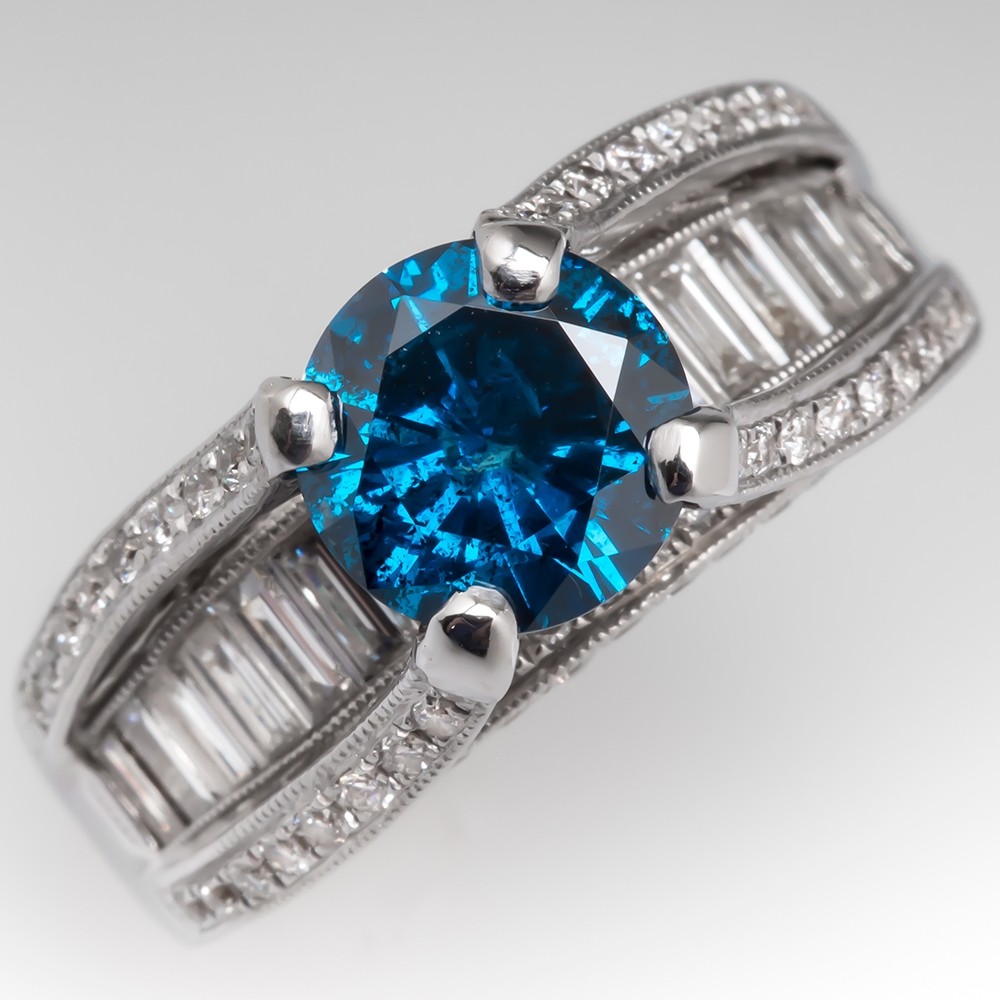Posted in: All Things Jewelry, Auctions/Results
 A stunning example of blue diamonds, this stunning blue and white diamond wring is set in 18k white gold. Photo ©2018 EraGem Jewelry.
This gorgeous wide band 18k white gold ring features a jaw-dropping 1.6 carat natural blue diamond. Surrounded by stunning emerald-cut and round brilliant white diamonds, the blue diamond just pops on this ring. Talk about the rarest of the rare, a blue diamond is perhaps one of the rarest precious gemstones on earth.
I wanted to write about blue diamonds after browsing the lots of Sotheby’s Hong Kong Magnificent Jewels and Jadeite auction. The top-grossing lot in this sale, a gorgeous blue diamond ring also mounted in 18k white gold, especially caught my attention.
A stunning example of blue diamonds, this stunning blue and white diamond wring is set in 18k white gold. Photo ©2018 EraGem Jewelry.
This gorgeous wide band 18k white gold ring features a jaw-dropping 1.6 carat natural blue diamond. Surrounded by stunning emerald-cut and round brilliant white diamonds, the blue diamond just pops on this ring. Talk about the rarest of the rare, a blue diamond is perhaps one of the rarest precious gemstones on earth.
I wanted to write about blue diamonds after browsing the lots of Sotheby’s Hong Kong Magnificent Jewels and Jadeite auction. The top-grossing lot in this sale, a gorgeous blue diamond ring also mounted in 18k white gold, especially caught my attention.
A Rare and Important Blue Diamond
Realizing an astonishing $13.8 million, the Ai Diamond in Sotheby’s Magnificent Jewels and Jadeite sale was a rare and important Vivid Blue and white diamond ring. Weighing an astonishing 5 carats, The Ai Diamond radiates with VS2 clarity. The GIA released a special monograph for this diamond, stating that the Ai Diamond is “saturated with the color of wisdom, harmony, and truth…” Natural blue diamonds are rarer than rare. Only one diamond in every 10,000 white diamonds found are colored. And only a very small portion of those colored diamonds are blue. In fact, Nature published a study reporting that only 1 in about every 200,000 diamonds have any blue tint. {source} The deeper the blue, the rarer the stone. Hence, the extraordinary price realized for this magnificent jewel.Mysterious Boron
Blue diamonds derive their color from trapped particles of boron in their carbon structure. Boron absorbs yellow light from the spectrum, allowing the color blue to radiate out from the stone. The boron found in blue diamonds has baffled scientists until recently. Boron is decidedly a crustal element, found primarily in the earth’s crust and rarely in the mantle. However, diamonds form deep within the earth’s depths, around 100 miles below the mantle. Furthermore, blue diamonds form even deeper down, as deep as 410 miles below the mantle.How Does the Boron Get Down There?
The study published in Nature reports that the Earth's recycling habits drive boron down deep enough for a blue diamond to form. When two tectonic plates grind together, one pushes the other beneath it. The force at which this occurs drives crustal elements down into the mantle, sometimes as deep as the 400 miles required for forming blue diamonds. Once these crustal elements find their way into the mantle, the earth recycles and reuses them to create new materials that later shoot back up to the surface by way of volcanic or tectonic ruptures. Perhaps it would be better to call this upcycling - most certainly a blue diamond proves an upgrade from a bit of carbon and boron! Let us help you upgrade your jewelry case! Give us a call to add this gorgeous blue diamond ring to your collection.6 years ago
4 view(s) 